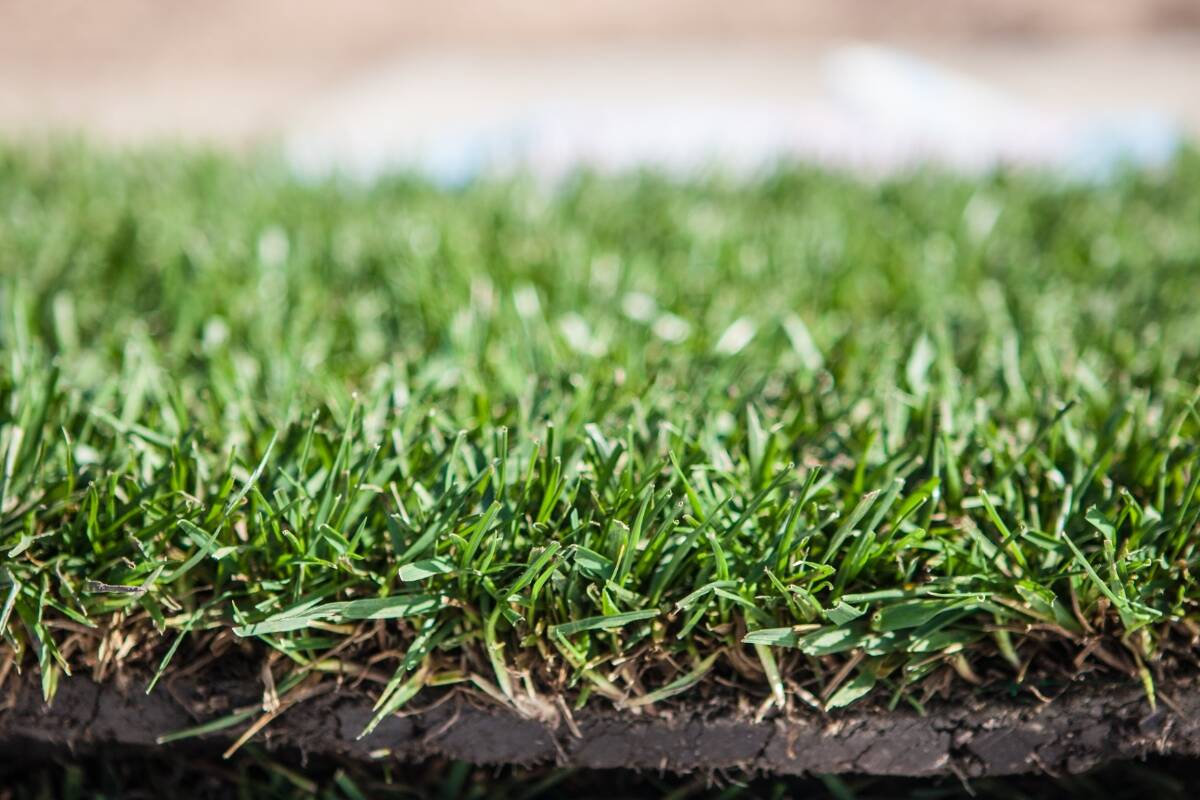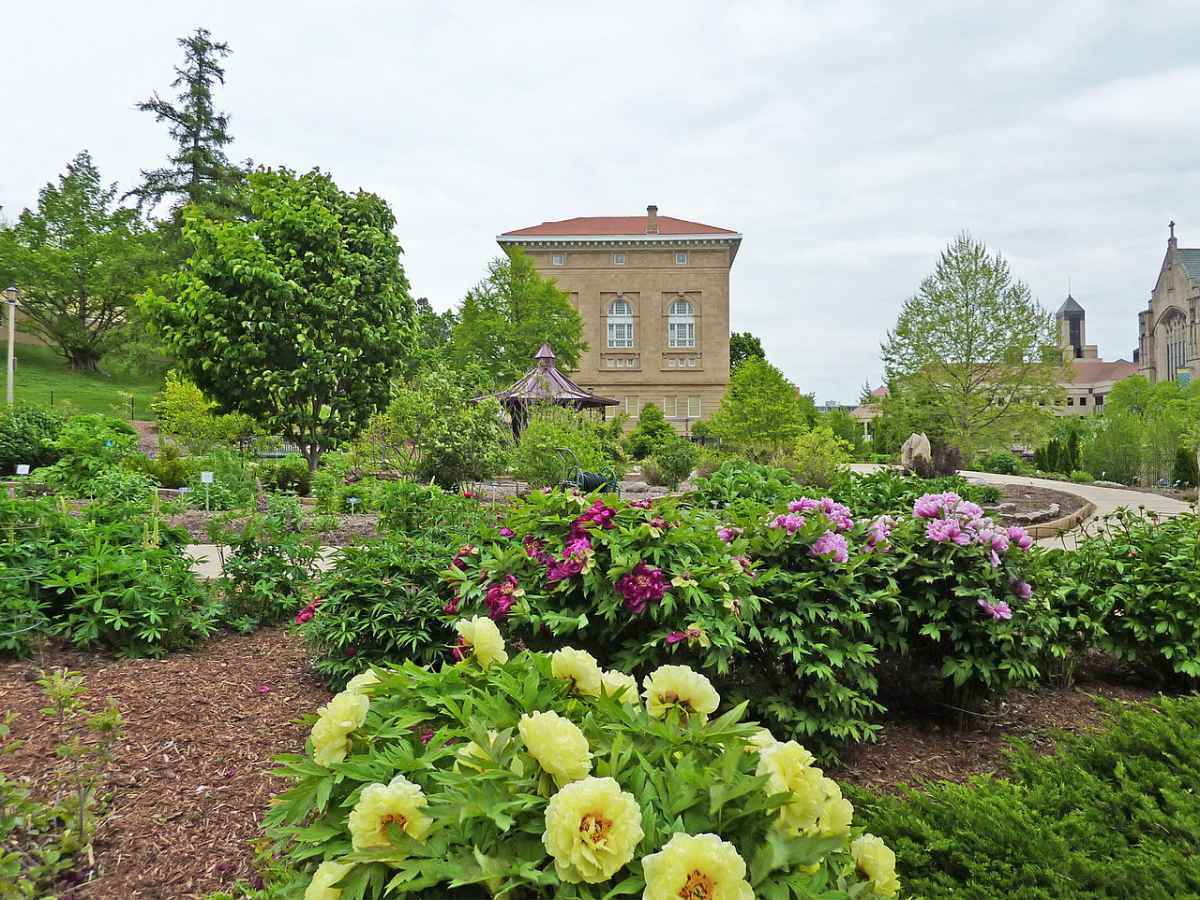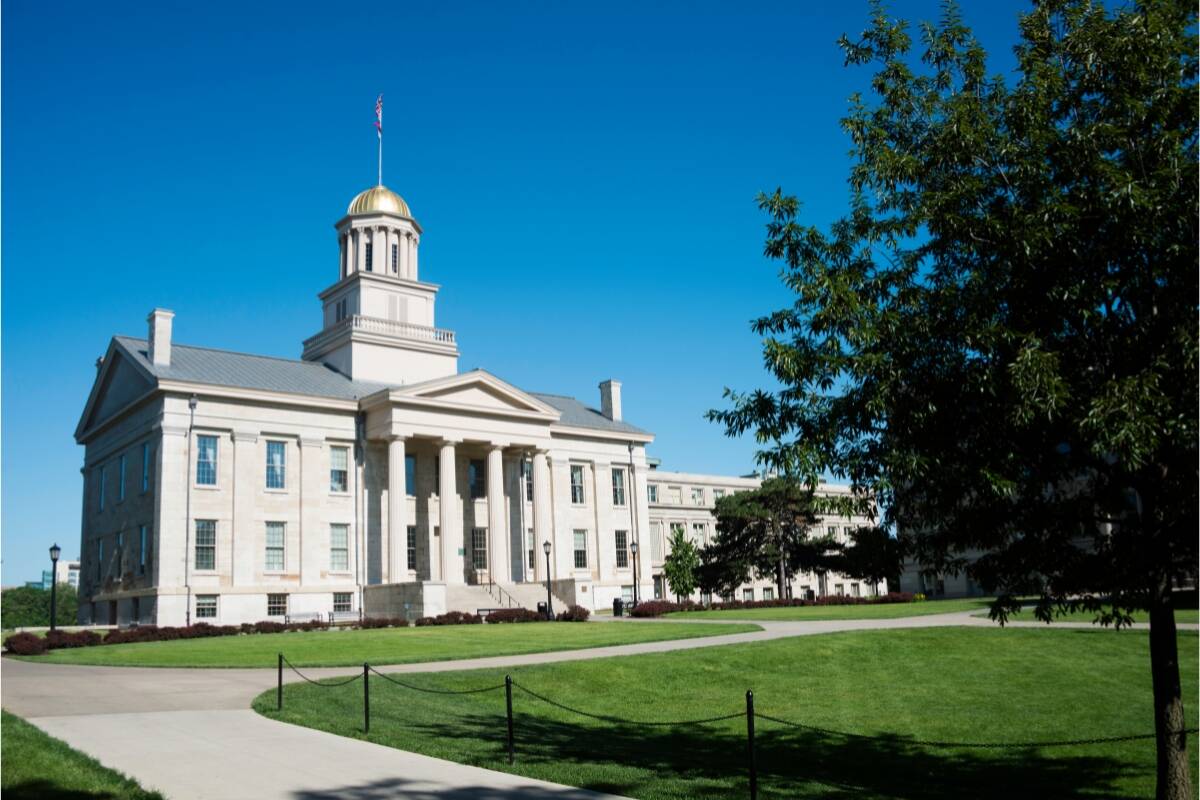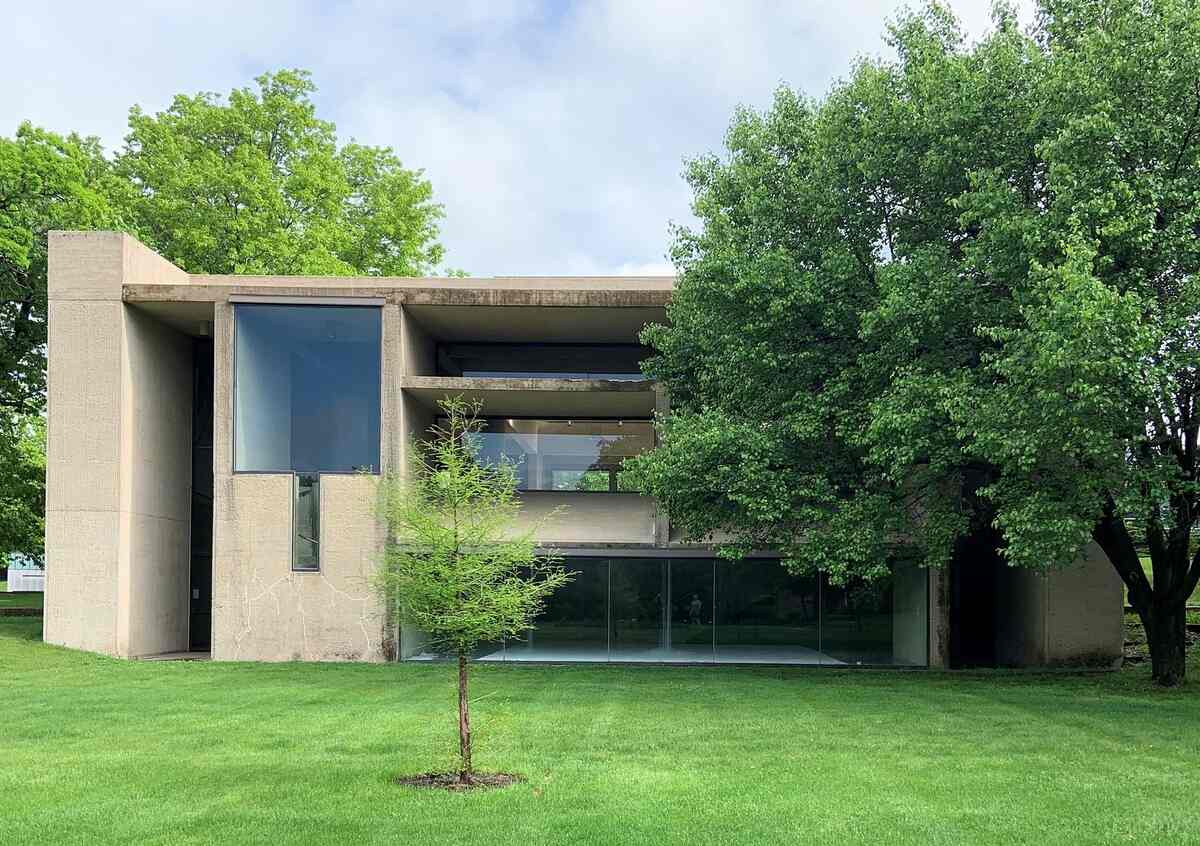
Are you looking for the best grass types for Des Moines but don’t know where to begin? You may ask yourself which grass is best for our climate or which can recover best from weekend flag football games. Here in Iowa, cool-season grasses thrive best and can handle a variety of situations.
These cool-season species perform well in the spring and fall when temperatures are moderate and can hold up under Iowa’s mild summers. That said, one warm-season grass, which we list as an “honorable mention,” is sometimes used as a cool-season grass alternative in low-maintenance Des Moines lawns.
Here are the five best grass types to plant in Des Moines, Iowa:
After detailing each grass type, we’ll show you how to choose the best grass type in Des Moines, so stay tuned until the end, or skip ahead.
1. Kentucky Bluegrass
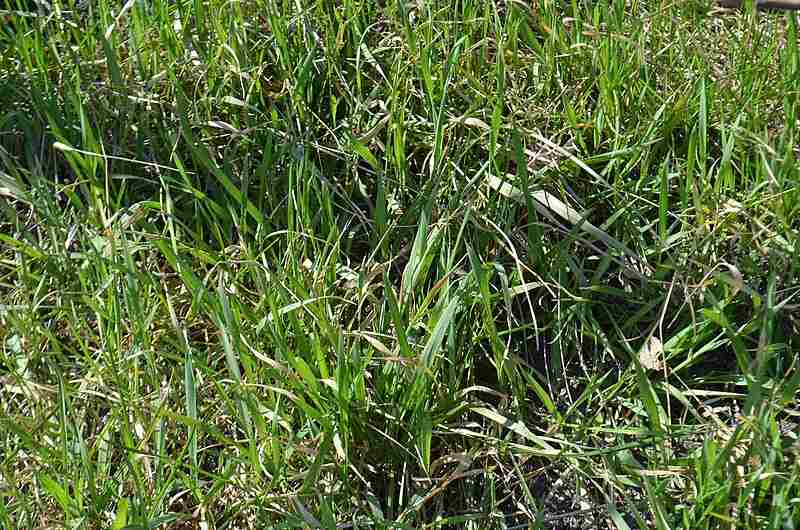
Photo Credit: Ethan2039 / Wikimedia Commons / CC BY-SA 4.0
Kentucky Bluegrass (KBG) is one of the most common grass types found in Iowa and is well adapted to Iowa’s soil and climatic conditions. It tolerates both full sun and partial shade but produces a higher quality lawn in full sun.
Kentucky Bluegrass can also tolerate high foot traffic well and outcompete many Iowa weeds due to its underground rhizomes (stems) that allow it to repair damaged areas with ease and form a dense turf. This cool-season grass is a naturalized plant in North America and holds up moderately well against frigid winter temperatures.
Note: KBG is susceptible to some diseases. Choose among improved KBG varieties for the best disease resistance.
- Classification: Cool-season grass
- Spreads by: Rhizomes
- Shade tolerance: Low
- Drought tolerance: Moderate
- Foot traffic tolerance: Moderate
- Maintenance needs: Moderate mowing frequency and high fertilization needs.
- Mowing height: Set mowing height between 2.5 and 3.5 inches.
- Potential for disease: Moderate to high; prone to several diseases, such as dollar spot, leaf spot, necrotic ring spot, summer patch, and stripe smut.
- Soil pH: 6-7.5
- Soil type: Performs best in well-drained, heavy soils with high fertility.
Other notes: Water requirements for Kentucky bluegrass are quite high during the growing season. However, during periods with no rain, it survives by going dormant and can survive from four to six weeks with no water.
Grass Seed Options:
– Jonathan Green (11970) Blue Panther Kentucky Bluegrass Grass Seed (3 lbs.)
– SeedRanch Midnight Kentucky Bluegrass Seed (5 lbs.)
– Jacklin Seed – Biltmore Blue Blend – 100% Kentucky Bluegrass (5 lbs.)
2. Fine Leaf Fescues
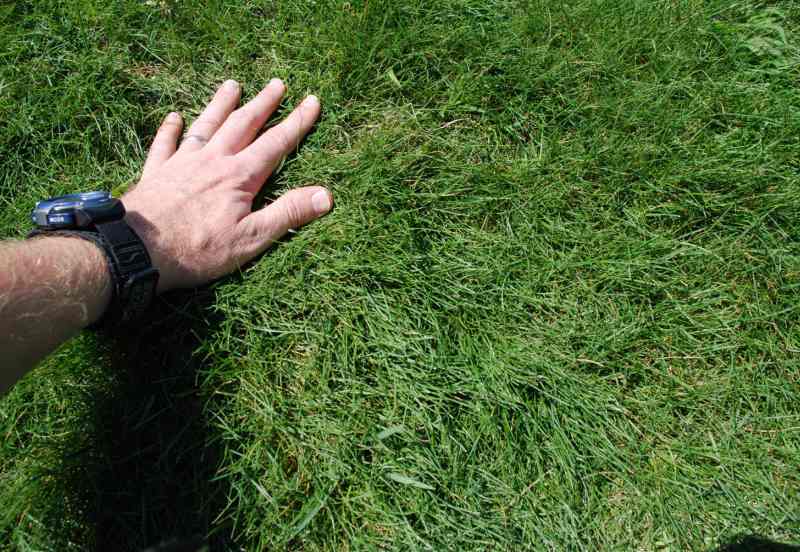
Aaron J. Patton, Ph.D. / Turfgrass Extension Specialist at Purdue University
Fine leaf fescues, a group of five fine-leaved species, require little water, making them a good choice for drought-prone regions. Additionally, they require low levels of fertilization and can grow in partial or highly shaded areas, depending on the variety.
However, fine fescues aren’t usually planted on their own. It’s a good idea to mix these species with another grass, like Kentucky Bluegrass, if you’re trying to plant grass in a lawn with both sun and shade.
Fine leaf fescues don’t hold up well under wet soils or intense heat and are not a good choice if you anticipate having excessive foot traffic on your lawn.
- Classification: Cool-season grass
- Spreads by: Creeping red fescue spreads by rhizomes, while other fine fescues are bunch-type grasses, such as Chewings, hard, and sheep fescues.
- Shade tolerance: Moderate to High, depending on species
- Drought tolerance: Moderate, depending on species
- Foot traffic tolerance: Low to Moderate, depending on species
- Maintenance needs: Low fertilizer and mowing needs.
- Mowing height: Set mowing height between 2.5 and 4 inches, depending on species.
- Potential for disease: Moderate. Common diseases include red thread, leaf spot, dollar spot, summer patch, and powdery mildew.
- Soil pH: 6-6.5
- Soil type: Will not perform well in wet soil conditions. Prefers drier soils and tolerates a wide range of soil types and fertility.
Other notes: While it has good drought tolerance, it can lose color quickly in a hot and dry climate. It’s often mixed with perennial ryegrass or Kentucky bluegrass in areas that have both shade and sunlight.
Grass Seed Options:
– Outsidepride Legacy Fine Fescue Grass Seed (5 lbs.)
– Eretz Creeping Red Fine Fescue Seed (choose your size)
– Outsidepride Creeping Red Fine Fescue Grass Seed (25 lbs.)
– Outsidepride Hard Fine Fescue Grass Seed (10 lbs.)
3. Perennial Ryegrass
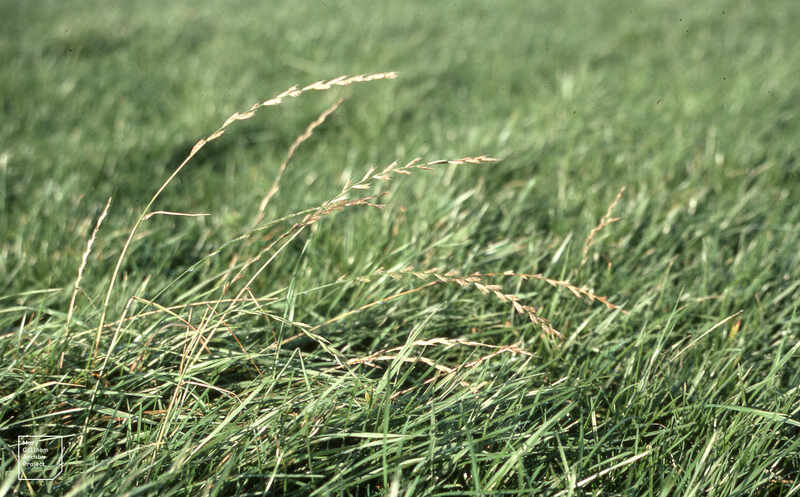
Photo Credit: Dr Mary Gillham Archive Project / Flickr / CC BY 2.0
Perennial ryegrass is a bunch-type grass used primarily in seed mixtures because it establishes fast. Due to this fast germination rate, it’s used to crowd out weeds while slower-growing grasses, like KBG, germinate. Perennial ryegrasses are the darkest green in color of all cool-season grasses and are medium to coarse texture-wise.
This grass holds up well to heavy foot traffic but is a bunch-type grass that is slow to recover from damage, as it does not have any rhizomes. You can plant perennial ryegrass in Iowa, but you need to be careful doing so, as it isn’t the best at responding to cold temperatures.
Perennial ryegrass is also vulnerable to many diseases. If you plant perennial ryegrass, consider overseeding with another species or using it in a seed mix for added disease resistance. It is, however, a good grass choice when you are trying to repair a damaged area of your lawn.
- Classification: Cool-season grass
- Spreads by: Has a bunch-type growth habit
- Shade tolerance: Low to moderate
- Drought tolerance: Low
- Foot traffic tolerance: High
- Maintenance needs: Moderate mowing and fertilization requirements. Thatch is not significant.
- Mowing height: Set mowing height to 1.5 to 2.5 inches
- Potential for disease: High. Common diseases include gray leaf spot, red thread, and leaf spot/melting-out.
- Soil pH: Can grow in soils with a pH between 5 and 8, but prefers between 6 and 7.
- Soil type: Prefers good drainage and fertility, but can tolerate some poor drainage.
Other notes: Perennial ryegrass is often mixed with Kentucky bluegrass due to its fast germination and high tolerance for foot traffic.
Grass Seed Options:
– Outsidepride Perennial Ryegrass Seed (5 lbs.)
– Eretz ProTurf Perennial Ryegrass Fine Lawn Seed (choose your size)
4. Tall Fescue

Aaron J. Patton, Ph.D. / Turfgrass Extension Specialist at Purdue University
Tall fescue is a coarsely textured grass with a medium to dark green color. It offers a delicate, soft texture that is appealing to the eye. Additionally, it holds up well under moderate shade and dry conditions.
Since tall fescue is a type of bunch grass, it struggles to recover when damaged and will instead require frequent reseeding. On the up side, it is the most heat, traffic, and drought tolerant of the cool-season grasses. It also tolerates wet soils pretty well.
It’s often used in situations where low maintenance is desired and is tolerant to alkaline and clay soils. Besides that, it’s suitable for most winters in Iowa. Tall fescues have a high growth rate and will require frequent mowing compared to Kentucky bluegrass.
- Classification: Cool-season grass
- Spreads by: Produces short rhizomes but has a bunch-type growth habit
- Shade tolerance: Moderate
- Drought tolerance: Moderate to High
- Foot traffic tolerance: Moderate
- Maintenance needs: Frequent mowing due to high growth rate. Does not produce significant thatch.
- Mowing height: Set mowing height to 3 inches tall.
- Potential for disease: Tolerant of most diseases when properly maintained.
- Soil pH: 5.5-6.5
- Soil type: Adapted to a wide range of soil conditions, but prefers fertile clay soils with good drainage.
Other notes: Maintain improved varieties at 3 inches; shorter mowing heights encourage weed growth. Tall fescue tolerates most Iowa winters.
Grass Seed Options:
– Triple-Play Tall Fescue Grass Seed Blend (5000 sq ft)
– Eretz Kentucky 31 K31 Tall Fescue Grass Seed (choose your size)
– Pennington The Rebels Tall Fescue Grass Seed Mix (7 lb.)
Honorable Mention: Buffalograss
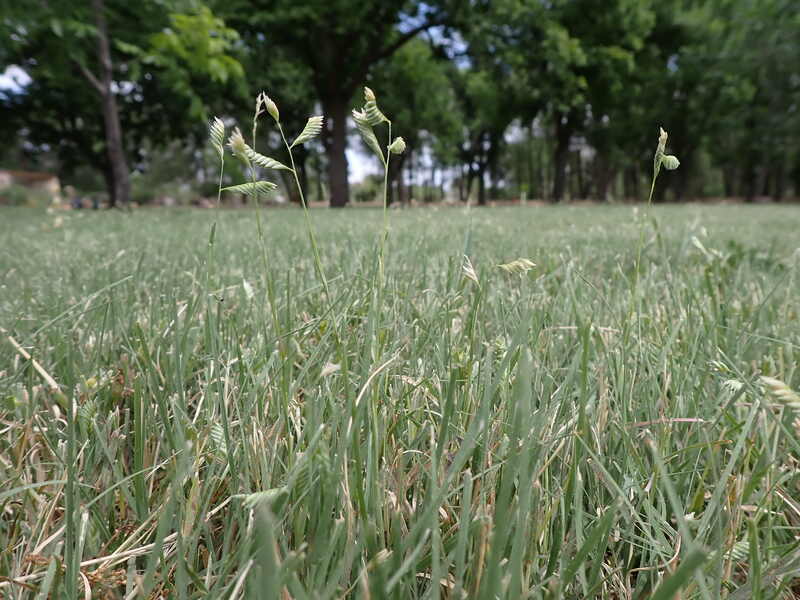
Photo Credit: Matt Lavin / Flickr / CC BY-SA 2.0
Buffalograss is finely textured and requires infrequent fertilizer, water, and mowing. Extreme heat, cold temperatures, and high pH soils are no problem for buffalograss, but its growth can be hampered by shade.
“Buffalograss is used in Iowa, and often appears in low-maintenance landscape areas along roadsides and city streets,” according to the Iowa State University Extension and Outreach. Buffalograss has historically been used for grazing animals.
Seeding this kind of grass can provide acceptable lawn quality even with minimal mowing. However, it will begin to go dormant and lose its green color after the first frost since this grass type is a warm-season species.
- Classification: Warm-season grass
- Spreads by: Stolons
- Shade tolerance: Low
- Drought tolerance: High
- Foot traffic tolerance: Low
- Maintenance needs: Low fertilizer and mowing needs. Develops thatch and requires weed control.
- Mowing height: Set the mowing height between 2 and 3 inches.
- Potential for disease: Good tolerance against diseases and insects
- Soil pH: 6.5-7.5
- Soil type: Native clay soils, not sandy soils
Other notes: Buffalograss can grow from 8-10 inches if left unmowed. The best time to seed this grass is around June 1 in Iowa.
Grass Seed Options:
– Everwilde Farms Buffalograss Seeds (1 lb. of seeds)
– Scotts Pursue Buffalograss with Natural Seed (1 lb. of seeds)
– Outsidepride Perennial Buffalo Grass Seed (2 lb. of seeds)
How to Choose the Best Grass Type in Des Moines, IA
If you need tips on what type of grass to select for your lawn, you came to the right place. Here are a few things to consider before buying grass seed in Des Moines.
High-Maintenance vs Low-Maintenance Grasses
Some grasses need more TLC, while others can thrive with less effort. Mowing, irrigation, and fertilizer needs eat up time and financial resources on the part of homeowners.
- Medium to high-maintenance: Kentucky bluegrass, perennial ryegrass, tall fescue
- Low-maintenance: Fine leaf fescue, buffalograss
Drought Tolerance
Lawn performance can be affected by environmental stresses such as summer droughts. During summer, the southern third of the state experiences long periods of high temperature. Choosing the right type of grass suitable for these conditions will help you keep your lawn in tip-top shape even in inhospitable times of year.
- Moderate to high drought tolerance: Tall fescue, Kentucky bluegrass, buffalograss, fine leaf fescues
- Lower drought tolerance: Perennial ryegrass
For more tips on strengthening your lawn during times of drought, check out 9 Summer Lawn Care Tips for Des Moines.
Shade Tolerance
Grass isn’t the only plant present in many lawns, so if you have trees growing as well, it could be a tricky situation. Picking the right grass type is important since shade is a common reason lawns start to thin out and lose density.
For lawns with both sun and shade, consider this mix to cover all areas beautifully: Fine fescue (10%) thrives in shade, perennial ryegrass (10%) can tolerate partial shade, and Kentucky bluegrass (80%) is ideal for parts of your lawn that receive full sun.
- Moderate to high shade tolerance: Fine leaf fescue, tall fescue
- Low shade tolerance: Kentucky bluegrass, perennial ryegrass, buffalograss
How You Use Your Lawn
People grow grass in their lawns for different reasons. Should it influence the way you pick species? Absolutely. Choosing grass types that resist both wear and recover quickly will work wonders if your lawn needs to withstand or recover from lots of wear and tear.
Here are some of our suggestions to make your life easier.
- Lawns “just for show”: Fine leaf fescues, buffalograss
- Moderate to heavy traffic (slow recovery): Tall fescue, perennial ryegrass
- Moderate traffic (good recuperative potential): Kentucky bluegrass
- For frequent family/neighborhood use: A mixture of Kentucky bluegrass and perennial ryegrass
When to Bring in the Professionals
Choosing the right grass type in Iowa might be a daunting task especially if you’ve never dealt with lawn work yourself. Fortunately, you don’t have to take care of it alone.
Contact a professional LawnStarter pro in Des Moines to make sure your lawn remains the pride of the neighborhood. They can help you choose the right grass as well as mow, weed, and trim the edges to keep it healthy throughout the year.
Main Image Credit: Daniel Hartwig / Flickr / CC BY 2.0
LawnStarter participates in the Amazon Services LLC Associates Program, an affiliate advertising program. LawnStarter earns revenue from products promoted in this article.


